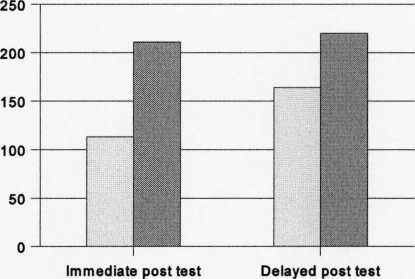5.4.2.2.3 Definition task
Scoring criteria for the Definition task
Each child had to answer two questions which were to provide definitions for the two target
words. To be scored correct, the response had to be provision of an appropriate definition
and incorrect the provision of an incorrect definition. For the present experiment a definition
was appropriate if it included any of the following information: (1) descriptive; (2)
contextual; (3) functional; (4) semantic (the different types of appropriate information are
described in Table 5.11). Each child could get a score from 0- 2.
Analysis
If all children were correct on the two target words, the maximum total score would be 384
for all the participants in each post test. As the Figure 5.10 below shows, children’s
successful performance reached the 54.9% during the immediate post test and 57.3% during
the delayed post test.
Figure 5.10 Children’s performance on the definition task for both post tests

Don't know∕irrelevant responses
Succesful performance
To what extent does children's performance on the definition task differ by age ?
If all children from each age group were correct on the two target words, the minimum total
score would be 128 for each age group in each post test. Figure 5.11 demonstrates children’s
performance on the definition task by age group for both post tests. Significant correlations
were found between children’s age and their performance on the definition task for both post
tests. The same pattern was found when children’s vocabulary and memory were controlled
for (see Table in Appendix 5.17).
136
More intriguing information
1. Design and investigation of scalable multicast recursive protocols for wired and wireless ad hoc networks2. Education as a Moral Concept
3. The name is absent
4. Peer Reviewed, Open Access, Free
5. The name is absent
6. Developments and Development Directions of Electronic Trade Platforms in US and European Agri-Food Markets: Impact on Sector Organization
7. The name is absent
8. The name is absent
9. Incorporating global skills within UK higher education of engineers
10. AGRICULTURAL TRADE IN THE URUGUAY ROUND: INTO FINAL BATTLE